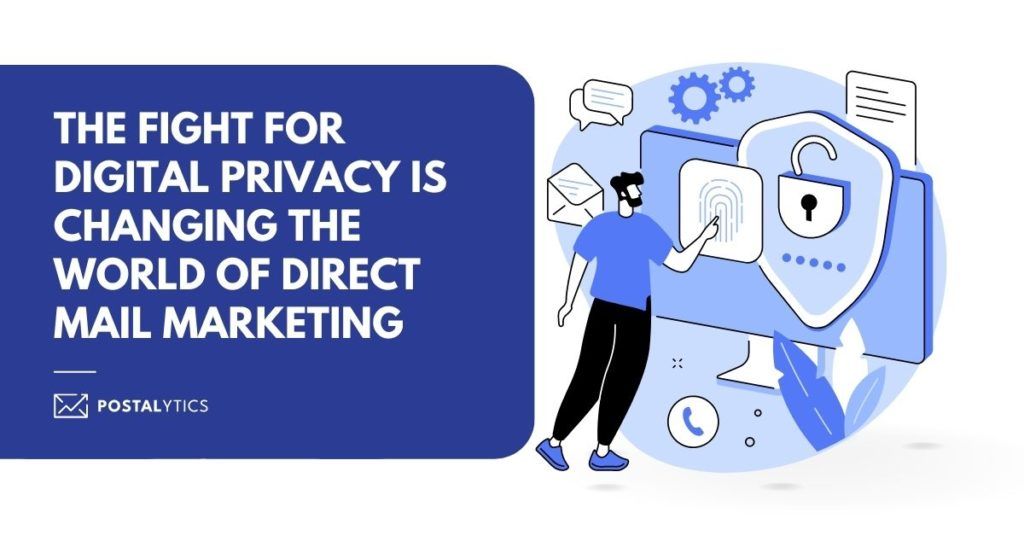
As the third-party cookie crumbles and digital privacy becomes a burning topic, regulators are rushing to define how online marketers and platforms use the internet. Many are left out of the loop with the latest developments and how they may affect businesses, careers, and the entire world of marketing.
New privacy rules implemented by governments and corporations are changing how companies use digital channels to attract and nurture leads. Google announced its intention to stop supporting third-party cookies. Apple made it possible for users to opt-out of tracking across applications. Even basic statistics like tracking who opens an email are unreliable because of privacy concerns.
Marketing laws and regulations are something new in the world of digital marketing. Rules are changing at a staggering pace, leaving digital marketers exploring other options to retain lead generation rates and relationships with customers.
While marketers must abide by the rules for gathering, using, and keeping consumer data, they have latitude in how that data is used to generate direct marketing mail messages. Using consumer preference data for segmenting a customer or prospect list is standard practice. Direct mail gives some functionality back to marketers that privacy rules are taking away.
Table of contents
- What is Digital Privacy?
- Federal Laws on Mail Delivery and Privacy
- Security and Privacy in the Digital Age
- Direct Mail Marketing in an Increasingly Regulated Digital Marketing World
- Direct Mail = Fewer Regulations & Clearly Defined Rules of the Game
- Implementation: Cutting through the clutter and noise
- Direct mail marketing: The clear winner of digital advertising laws
What is Digital Privacy?
Privacy describes dissimilar but related views. The media tries to define different privacy concepts, but descriptions often overlap. General ways of thinking about privacy can be divided into two categories:
1. Freedom from government observation and intrusion
2. Freedom to control one’s own personal information
The electronic landscape complicates these definitions and the understanding of privacy. In digital marketing, privacy means that website visitors have control of their personal data. Control means visitors can specify whether they want to share information and indicate how the organization collecting their information can use it. Privacy rights are individual rights independent of technology.
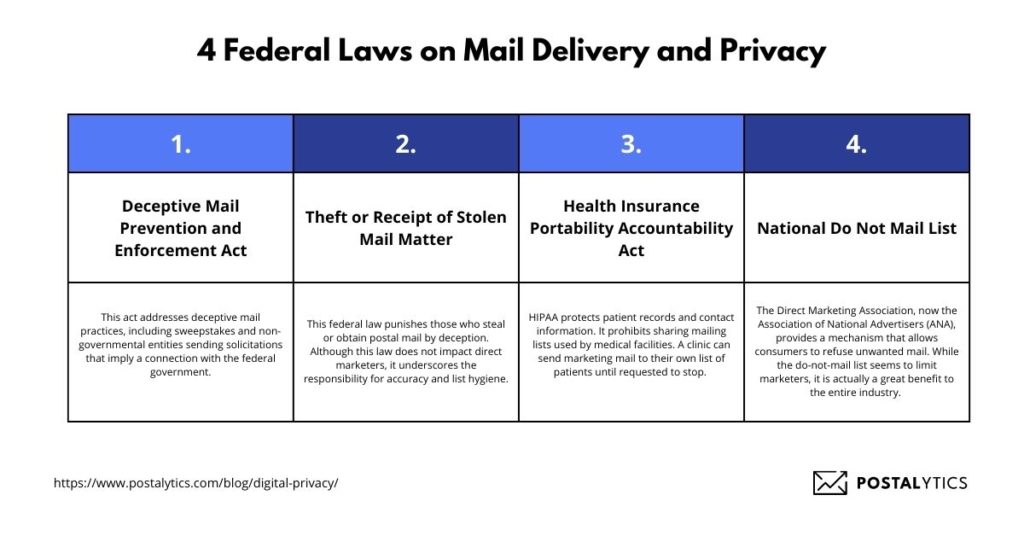
Federal Laws on Mail Delivery and Privacy
The granddaddy of all mail privacy laws is the Mail Privacy Statute of 1971. This law protects mail from being opened by another individual without the recipient’s consent. In other words, mail tampering is illegal under US federal laws.
However, no federal laws prohibit direct mail advertising. But regulations governing its use are on the books:
- Deceptive Mail Prevention and Enforcement Act (DMPEA) (39 U.S.C., Section 3001). This act addresses deceptive mail practices, including sweepstakes and non-governmental entities sending solicitations that imply a connection with the federal government.
- Theft or Receipt of Stolen Mail Matter (Title 18 U.S. C., Section 1708). This federal law punishes those who steal or obtain postal mail by deception. Although this law does not impact direct marketers, it underscores the responsibility for accuracy and list hygiene.
- Health Insurance Portability Accountability Act (HIPAA). HIPAA protects patient records and contact information. It prohibits sharing mailing lists used by medical facilities. A clinic can send marketing mail to their own list of patients until requested to stop.
- National Do Not Mail List. The Direct Marketing Association, now the Association of National Advertisers (ANA), provides a mechanism that allows consumers to refuse unwanted mail. While the do-not-mail list seems to limit marketers, it is actually a great benefit to the entire industry. Eliminating non-buyers makes mail campaigns targeted and reduces printing and postage waste. ANA members cleanse their lists of people on the national do-not-mail database. Non-ANA member marketers are not obligated to comply, though many of them do comply in the spirit of good practice and avoiding waste.
Well-executed regulation resolves legal issues in marketing and brings clear rules of the game to the industry. Clear rules create price stability and better conditions for marketers, businesses, and consumers.
Almost every form of traditional marketing is regulated to offer the best possible value for you. Digital channels have evaded the hand of the law because they were new and hard to grasp. But the regulators now have a clear picture of what’s ahead.
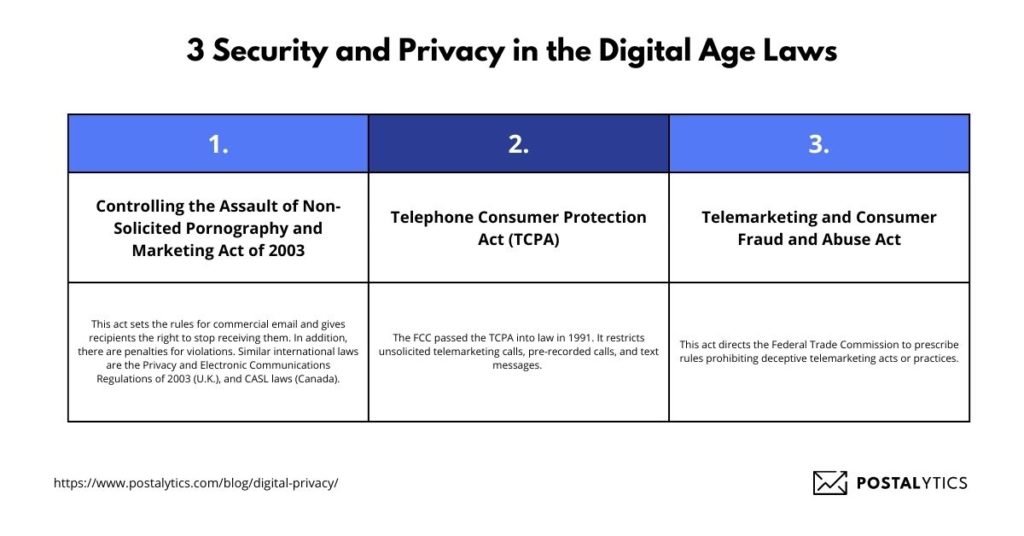
Security and Privacy in the Digital Age
International regulations, such as the European Union’s General Data Protection Regulation, limit the processing of personal information across all channels.
Federal laws related to specific electronic channels include:
- Controlling the Assault of Non-Solicited Pornography and Marketing Act of 2003 – CAN-SPAM Act. This act sets the rules for commercial email and gives recipients the right to stop receiving them. In addition, there are penalties for violations. Similar international laws are the Privacy and Electronic Communications Regulations of 2003 (U.K.), and CASL laws (Canada).
- Telephone Consumer Protection Act (TCPA). The FCC passed the TCPA into law in 1991. It restricts unsolicited telemarketing calls, pre-recorded calls, and text messages.
- Telemarketing and Consumer Fraud and Abuse Act. This act directs the Federal Trade Commission to prescribe rules prohibiting deceptive telemarketing acts or practices.
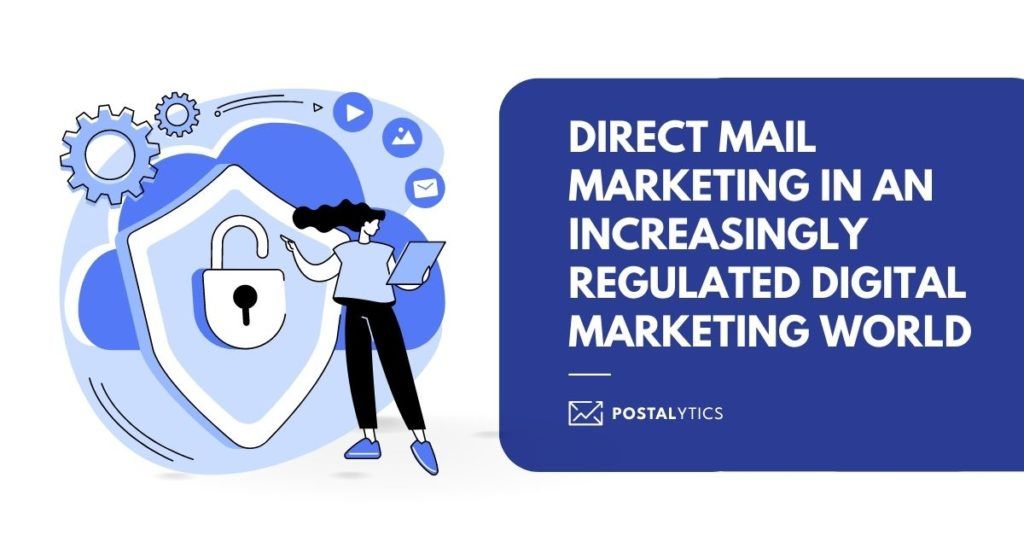
Direct Mail Marketing in an Increasingly Regulated Digital Marketing World
From corporate data breaches affecting thousands to your next-door neighbor whose identity was stolen, consumers are concerned with privacy. The digital landscape continues to see new rules and regulations to protect consumer privacy and data. As rules are added, the importance of direct mail becomes clear. Direct mail marketers enjoy more freedom to manage data to reach the intended audience than they experience with electronic media. Best of all, the message gets in the hands of the customer. They interact with the mail piece, and it stays on their desk or the kitchen table for days. Direct mail boosts the effectiveness of other channels.
Direct Mail = Fewer Regulations & Clearly Defined Rules of the Game
Direct mail is the easiest way to connect with customers and comply with data privacy rules.
Regulations for email and text messages are complex, and many states have their own rules. California, Colorado, Connecticut, Utah, and Virginia have their own consumer data privacy laws. The Postal Service has clear standards for mail sent to all states. Mailers are provided with a set of requirements and templates.
The templates contain the information mailers must include on a mail piece. As a governmental agency, the USPS is committed to upholding state and federal laws. They have internal security measures and conduct regular employee training to protect customer data.
Implementation: Cutting through the clutter and noise
Digital marketing channels are increasingly saturated. So much so that the response rate is lower than ever.
Direct mail offers tangibility, permanence, and a visual experience. It cuts through the digital chatter. The challenge is legally connecting digital to direct mail for leveraging data gathered from web pages, email, and social media. Postalytics provides enterprise-grade direct mail automation with workflow, integration, and analytics.
Integrate Postalytics with your existing CRM, marketing automation, or eCommerce software and harness the power of automated direct mail marketing. From one to 100,000 mail pieces, Postalytics complies with all relevant laws and regulations. Safely use our direct mail platform to make your digital channels more responsive.
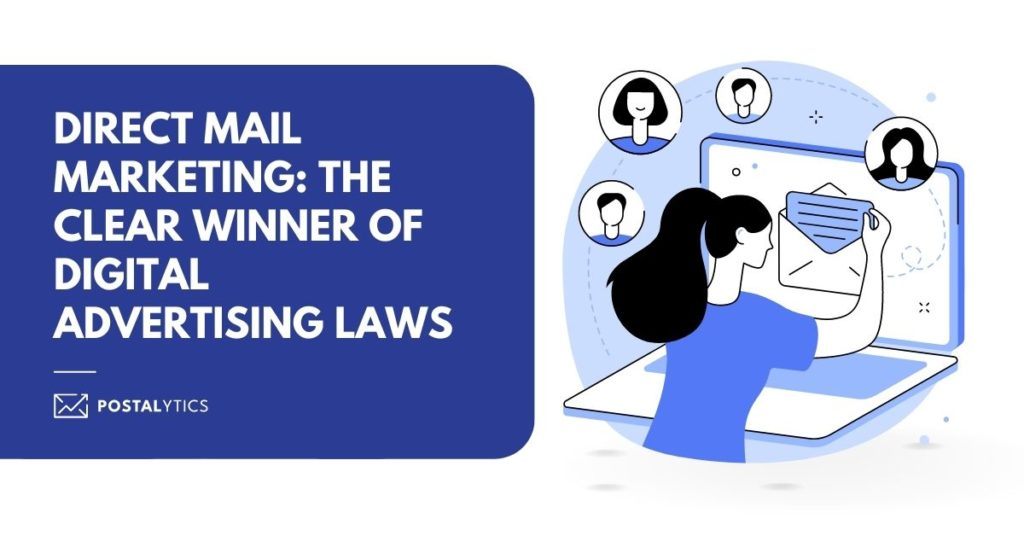
Direct mail marketing: The clear winner of digital advertising laws
As digital channels slowly lose relevance and settle into a rigidly defined form, one marketing channel is leaping ahead.
Direct mail marketing has received its modern sequel. Marketers can now create, design, automate, ship, and track their results from a single dashboard in their Postalytics accounts. You can add personalized QR codes and pURLs leading your prospect to a pre-made website with an additional offer or a lucky draw to win products or services. Savvy salespersons will figure out exactly when to pick up the phone and reach out to their next customer – all made possible by direct mail marketing technology developed by Postalytics.
So, what are you waiting for? Get your free account today.
About the Author

Dennis Kelly
Dennis Kelly is CEO and co-founder of Postalytics. Dennis joined Boingnet, the predecessor to Postalytics, in 2013. Boingnet was focused on providing print and direct mail marketing service providers the ability to add digital marketing channels to their direct mail campaigns. Postalytics is Dennis’ 6th startup. He has been involved in starting and growing early-stage technology ventures for over 30 years and has held senior management roles at a diverse set of large technology firms including Computer Associates, Palm Inc. and Achieve Healthcare Information Systems.
